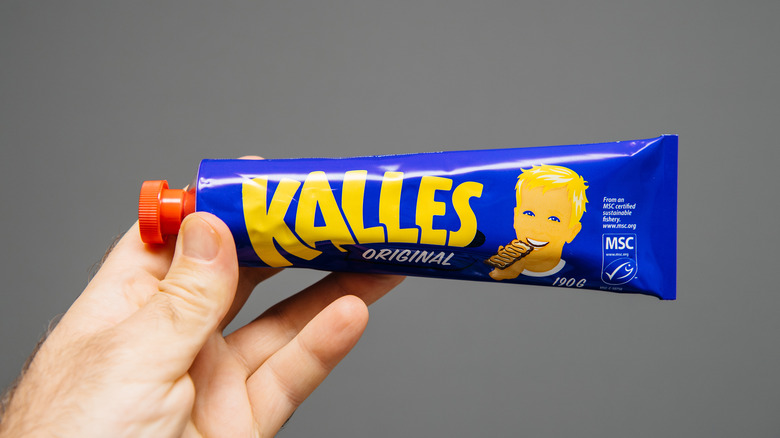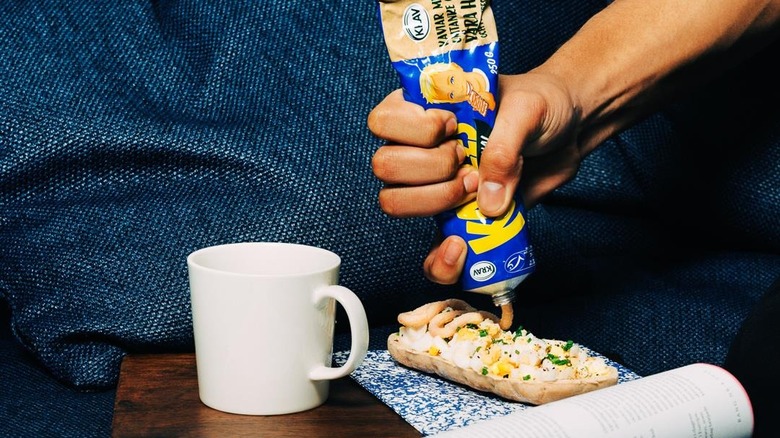The Caviar Paste Marcus Samuelsson Can't Stop Using For Breakfast
In a scene inundated by trends like edible gold leaf and other astronomically expensive ingredients, caviar has maintained its status as one of the fanciest — and simplest — of foods. The best of this delicacy comes from a fish called a sturgeon, which resembles an armored shark and hasn't changed much since prehistoric times. Likewise, caviar has remained a notoriously luxurious food that's slurped off special spoons (per Imperia Caviar), noshed on with champagne, and served atop high-end brunches around the world.
According to Esquire, most caviar hailed from Russia until the late '80s, after which many other countries heavily overfished sturgeon in the wake of the Soviet Union's dissolution. Since then, caviar comes with a price that goes beyond its tremendous dollar value. World Wildlife Fund reports that sturgeons are critically endangered, and most of the time, the fish are killed in order to harvest their eggs, as explained by The Los Angeles Times. Fortunately, there is a way to enjoy fish eggs, or roe, with a caviar-adjacent product that's not only wildly popular but also a favorite go-to ingredient of Ethiopian-Swedish chef and restaurateur Marcus Samuelsson.
Kalles Kaviar to the rescue
Marcus Samuelsson told Yahoo! Life that he's always got a tube of Kalles Kaviar on hand, which he describes as a "Swedish cod roe [that's] like a breakfast spread" and adds that "it's not fancy." Wait, non-fancy caviar? What's roe, then? MasterClass explains that both roe and caviar are fish eggs. But caviar is specifically a salted roe that only comes from wild sturgeons of different species for which the caviar is named: among them beluga and osetra. Caviar also must be treated with a process called malossol ("little salt") to help preserve it — minimal intervention compared to roe that may have a longer ingredient list.
Furthermore, MasterClass notes that in North America, other kinds of roe are often branded and sold as caviar. Products like Kalles Kaviar — which we've established is not actually caviar — reduce the strain on the dwindling wild sturgeon population and serve as a suitable culinary stand-in for the problematic delicacy. So what is this miraculous stuff? Kalles Kaviar's label describes it as a creamed smoked cod roe.
How to eat Kalles Kaviar
So how does it taste? "Swedish," according to Nordic Expat Shop, alluding to the brand's slogan: very brine-forward, but with an undercurrent of sweetness. Ateriet says it's a bit fishy and is among several sources comparing it to Marmite. An anonymous Amazon reviewer wrote, "Kalles Kaviar burst like a shining memory of Nordic myth into my life...the creamed roe fired all the bliss neurons in my brain." One Amazon listing explains that Kalles Kaviar is usually enjoyed on buttered Swedish crispbread, and reviewers chime in to praise it as a toast spread, or even on Ritz crackers. IKEA suggests dill and chive omelets, and Ateriet recommends it on sandwiches and explains that in Sweden, people insist on it with hard-boiled eggs.
Chef Marcus Samuelsson told Yahoo! that he enjoys it on scrambled eggs, and in an interview with Time Out, he says he also puts it on avocados. If you're looking to try real caviar, might we suggest (via Food Network) Samuelsson's tandoori smoked salmon ravioli with goat cheese and osetra caviar? Though if you're not ready to dive down the roe rabbit hole, stop in his New York restaurant Hav & Mar and order the Swediopian, a plate of berbere-cured salmon topped with mustard seed "caviar." At least you'll spare a sturgeon.


